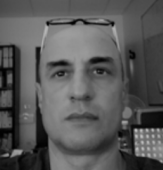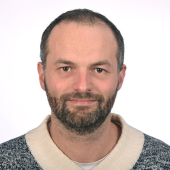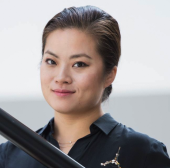|
|
|
Lectures and Keynotes > Day 2 - Modeling
Day 2 - Modeling09:00-10:30: Lecture "The Model of Cosserat Rods: A Standard for Modeling Soft and Continuum Robots" - Frédéric BoyerAbstract: At the crossroads of rigid body mechanics and continuum mechanics, the Cosserat rod model is an ideal tool for the study of slender bodies undergoing large deformations. Initially presented as an abstract object by the Cosserat brothers, it has been applied over time to many problems in engineering sciences such as structural mechanics, where it gave birth to the geometrically exact finite element method (GE-FEM), in ocean engineering for the simulation of submarine cables, or in computer graphics, for the needs of interactive simulation. In robotics, whether for the study of hyper-redundant bioinspired locomotion, the simulation, and control of non-invasive continuous medical robots or for the design of new concepts of soft arms, it is gradually becoming a standard, comparable to the multi-body models of rigid robotics. In this course, we will present this model and some of its uses for robotics. We will start by defining a Cosserat media and the resulting beam kinematics. On this basis, we will establish the equations of the dynamics and the constitutive law of Cosserat rods. This model will then be exploited for the modeling of soft and continuous robots. The connection of Cosserat beams in a robotic architecture as well as the modeling of distributed actuation will be given special attention. On the basis of these results in modeling, we will address the problems of simulation (shooting method, Lagrangian), and control of continuous and soft robots.  Bio: Frédéric Boyer was born in France in 1967. He received the Diploma in mechanical engineering from the Institut Nationale Polytechnique de Grenoble, Grenoble, France, in 1991, the Master of Research degree in mechanics from the University of Grenoble in 1991, and the Ph.D. degree in robotics from the University of Paris VI, Paris, France, in 1994. He is currently a Professor with the Department of Automatic Control, IMTAtlantique, Nantes, France, where he is a member of the Robotics Team, Laboratoire des Sciences du Numerique de Nantes (LS2N). His current research interests include ´ structural dynamics, geometric mechanics, and biorobotics (locomotion dynamics and underwater electric sensing). Dr. Boyer received the Monpetit Prize from the Academy of Science of Paris in 2007 for his work in dynamics and the French ”La Recherche Prize” in 2014, for his works on artificial electric sense. He has coordinated several national projects and one European FP7-FET project on a reconfigurable eel-like robot able to navigate with electric sense. 11:00-11:30: Lecture "Continuum Mechanics for the Modeling of Elastic Bodies and Numerical Resolution" - Christian DuriezAbstract: This class will aim at giving the basics of the mechanics of deformable solids (continuum mechanics). I will then explain how numerical models can be used to solve these equations, in particular finite element models. Finally, we will see how we can apply these models in a deformable robotics context, in particular for real-time execution.  Bio: I received an engineering degree from the Institut Catholique d’Arts et Métiers of Lille, France and a PhD degree in robotics from University of Evry, France. My thesis work was realized at CEA/Robotics and Interactive Systems Technologies followed by a postdoctoral position at the CIMIT SimGroup in Boston. I arrived at INRIA in 2006 in the ALCOVE team to work on interactive simulations of deformable objects and haptic rendering. In 2009, I was the vice-head of SHACRA team and focus on medical simulation. I am now the head of DEFROST team, created in January 2015 . My research topics are Soft Robot models and control, Fast Finite Element Methods, simulation of contact response and other complex mechanical interactions, new algorithms for haptics… All my research results are developed in SOFA, which is a framework that we co-develop with other INRIA teams. I was also one of the founders of the start-up company InSimo which use our research results for a fantastic humanitarian project
13:30-14:30: Keynote "Reconfigurable Robots for Real Intuitive Interaction" - Jamie PaikAbstract: A truly ubiquitous environment is where human-machine interactions are intuitive, reliable, and compatible. This requires an intelligent platform that is versatile and adaptable to evolving tasks and dynamic environments. While there are extensive efforts in addressing this challenge through massive data and learning algorithms, there is yet to be a cohesive solution to improve the actual physical interactions. Recent developments in soft robots with their unconventional material-based solutions and modular robots with a multitude of configurations propose possible avenues to extend the capacities of robotics. This talk will highlight the recent progress in soft-material robots and reconfigurable origami robots that aim at achieving comprehensive solutions toward diverse "softer" human-robot applications.  Bio: Prof. Jamie Paik is director and founder of Reconfigurable Robotics Lab (RRL) of Swiss Federal Institute of Technology (EPFL). RRL’s research leverages expertise in design and advanced manufacturing toward reconfigurable robotic platforms that push the physical limits of material and mechanisms. Her latest research effort is in soft robotics and self-morphing Robogami (robotic origami). Robogami transforms autonomously its planar shape to 2D or 3D by folding just like the paper art, origami. Soft material robots and robogamis are designed to be interactive with the users and their environments through both innate and active reconfigurations. Such characteristics of the RRL’s robots have direct applications in medical, automobile, space, communication, and wearable robots. While this novel technology has been published in multiple academic journals such as in Soft Robotics Journal, IEEE Transactions in Robotics, Nature, and Science, RRL’s spin-offs, MIROS and Foldaway-Haptics, have pushed the boundaries of the industrial applications of these robots as seen in TED conference 2019. The latest robogami is part of Mercedez’s 2020 concept car, Avatar, presented during CES 2020, and MIROS in 2023 and 2024. |


